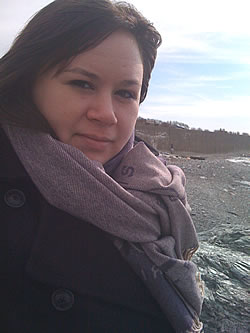|
I didn't want to write "Tuesday." September 11th just felt too big.
I was living in New York at the time and everyone I knew had his or her own personal story about that day and its impact. I wasn't sure a story inspired by mine warranted its own telling. Or, that I could even do it justice.
It seemed to me that we hit a critical mass of images and stories that represented that day no matter how representative they actually were.
But, it was my turn to submit to workshop at Sarah Lawrence and the family stories I had been working on were becoming impossible to write. They were layered and complex and everything about them confused me.
My advisor, Jo Ann Beard, suggested I put the family stories aside for a while and write something that was all my own, in which my family members were not major characters. At a loss, I offered my experience of September 11th.
There is something so natural in the way we verbalize a story to someone. We intuit how to create those moments of interest, suspense, and closure. A live audience, if even just one person, gives us an immediate reaction and the subtle cues that let us know what is working.
Just telling the story out loud helped me realize that there was something new to offer about that Tuesday. As I told my story, Jo Ann started writing a list that began:
- white pages
- city lights
- building footprints
And it went on.
Then, she handed me the list and said, write it. Start with these images. Just describe them one by one. Think of some more images to add to the list if you can. It doesn't have to be a whole story. Just think about each one of these items and write down what you remember. Turn in whatever you come up with for workshop.
I left that meeting feeling that there is a way to tell any story and that all we need is to find a way in.
The way in is something I've always struggled with. To write, I need to enter a whole other state of mind, where time slows down and my perception is sharp on details. Where I'm focused, but open. Where creativity blends with the critical. That state is quite different from the state of mind I need to live the rest of my life—to get things done, make money, socialize.
I've always had to trick myself over the hurdle and into that other world. I'd wake up so early to write that I hardly realized I was there until I already was. I'd remove myself from settings that were distracting and then still avoid the page.
The list was tangible, non-threatening, and forgiving. It made me see the emotional heart of the story and let me focus on what came more naturally to me—description and scene setting.
Structure and time have always been more abstract for me and, therefore, difficult to figure out. As I looked at my list of descriptions, the structure began to show itself. I could see the action between the images, and the meaning that the images had to the rest of the story. I could sense movement and even a little bit of plot.
By the time I had to hand in for workshop, I had a piece very similar to the one that is published in Issue 84 of Glimmer Train.
It took a dozen or more revisions from that first draft, a visit back to Ground Zero, and some help from my writer friends before it was ready for publication. But what did not really change throughout all that were the descriptions of those images.
That technique changed me as a writer. It used something that came easily to me to help me learn something that was difficult for me. But most importantly, it gave me a way in.
Now, before I sit down to write, I collect images for a while. I try bits of the story out on whoever will listen to remember my audience. When I finally do sit down, I am less scared of the blank page.
| 

